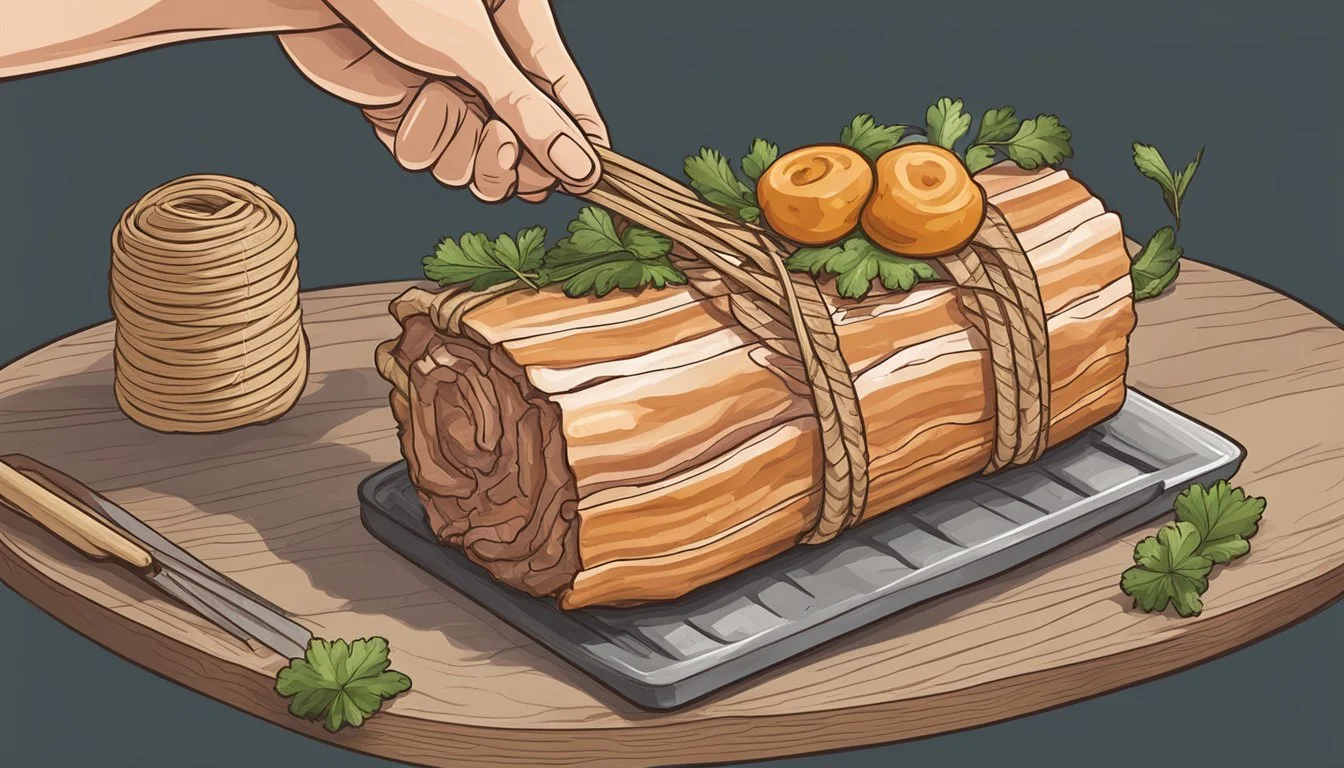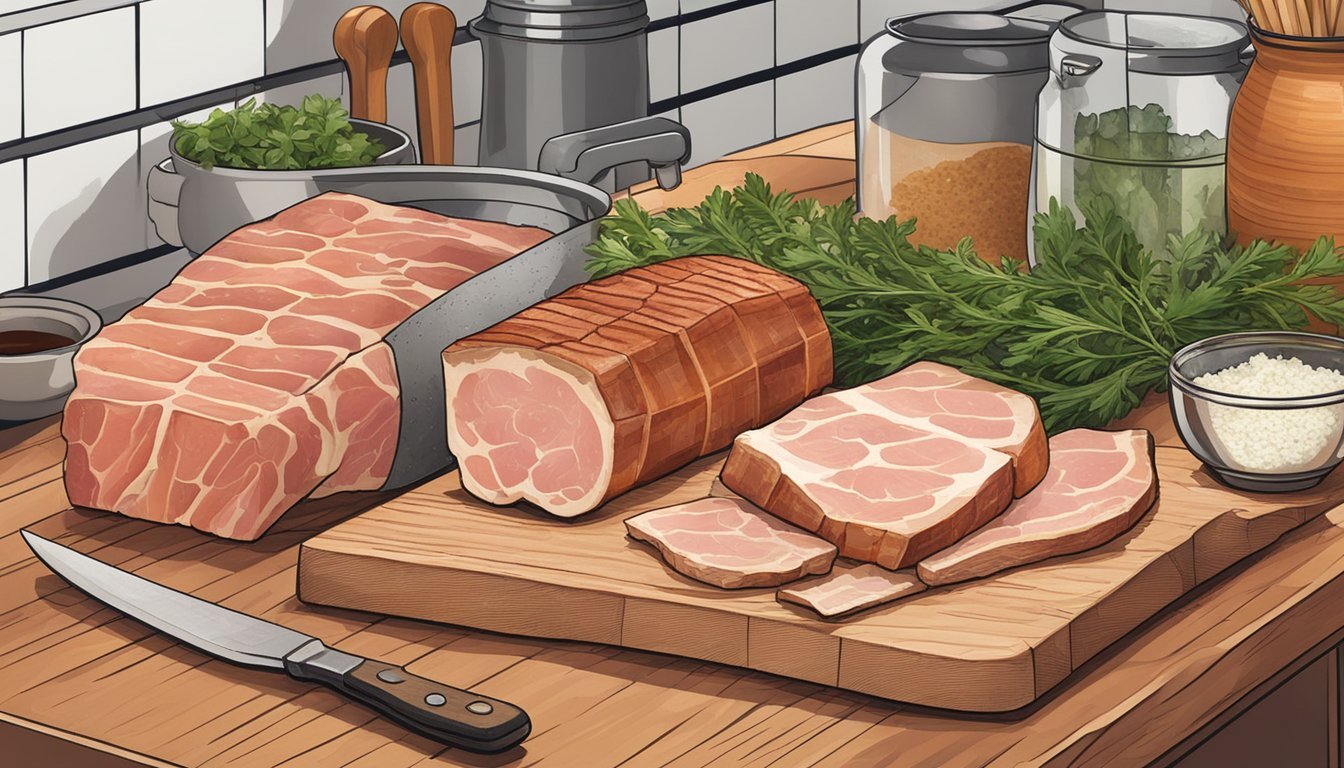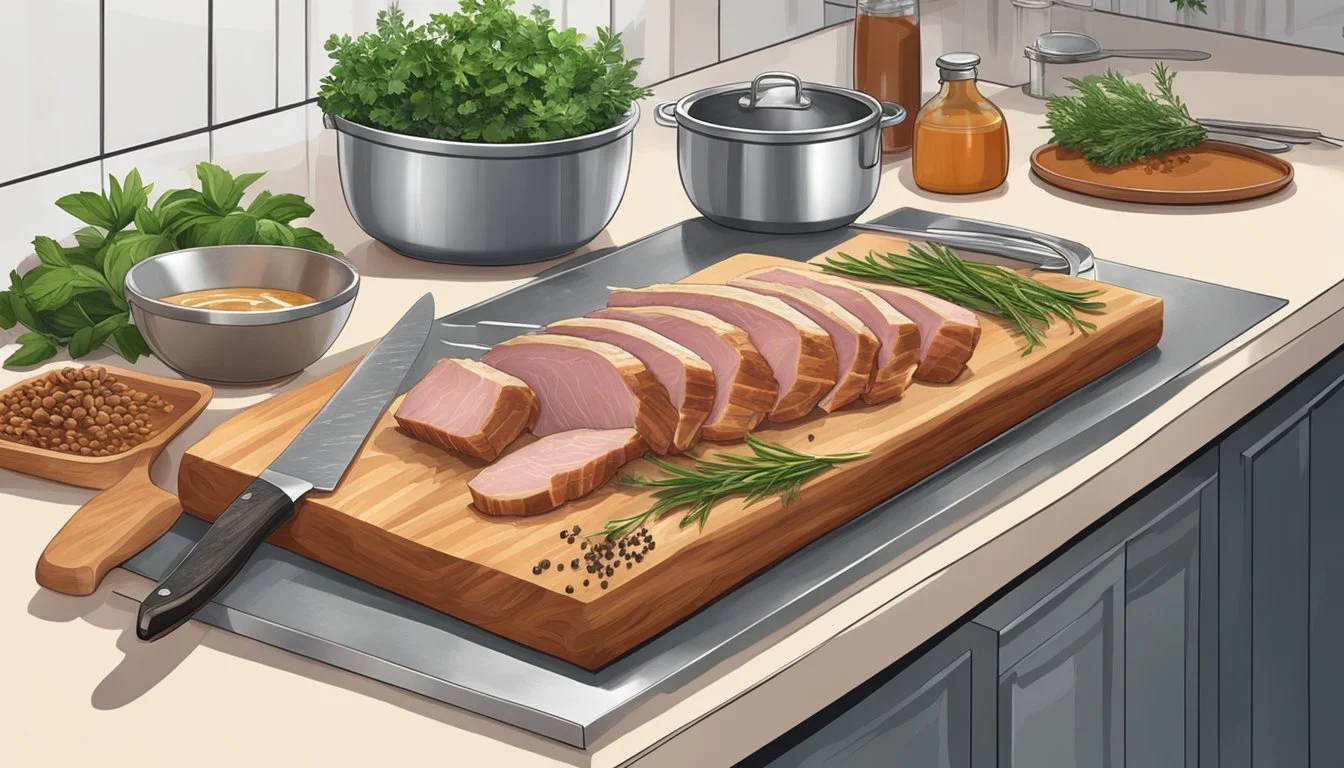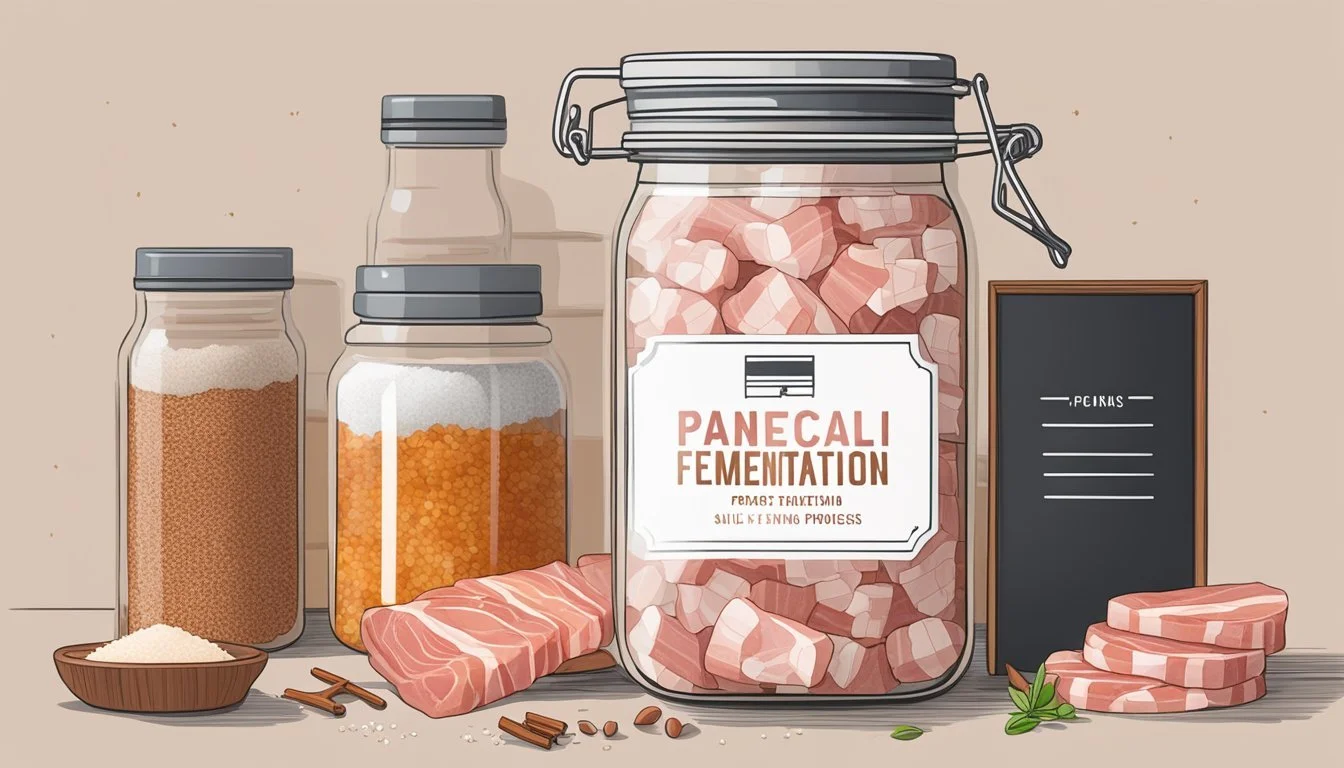How to Ferment Pancetta
Mastering Traditional Italian Cured Pork Belly
Pancetta, the Italian cousin to bacon, is a type of cured pork belly (What wine goes well with pork belly?) renowned for its rich flavor and versatility in culinary application. Unlike bacon, which is typically smoked, pancetta undergoes a curing process involving salt and other seasonings, which imparts a complex, savory taste to the meat. This traditional Italian delicacy has been a staple in many dishes, providing a depth of flavor that enhances the overall dining experience.
Making homemade pancetta involves a meticulous process that starts with selecting quality pork belly. The curing process requires patience and precision, where the meat is coated with a carefully measured blend of salts, spices, and sometimes aromatics like garlic or herbs, reflecting the rich culinary heritage of Italy. Once the meat is prepared, it's left to cure for a specific period, during which the salt penetrates the meat, intensifying its flavors and preserving it.
The key to successful pancetta is in the preservation and fermentation that occurs during the curing and aging stages. The environment in which pancetta ferments is kept controlled to ensure safety and to achieve the desired texture and tang. For those inclined to create their own pancetta at home, understanding the balance of seasoning, temperature, and time is essential to crafting an authentic slice of Italy.
Selection of Pork Belly
The key to exquisite homemade pancetta starts with the selection of a high-quality pork belly. One should consider the freshness and characteristics of the meat, and choose between skin-on or skinless options depending on their recipe needs.
Identifying Quality Pork Belly
When searching for quality pork belly, the discerning cook looks for firm and pink meat with a healthy proportion of fat to lean. The fat should be creamy white rather than yellow or gray. Ideally, the pork belly comes from well-raised pigs and is obtained fresh from a reputable butcher. One tells if pork belly is fresh by checking that it has a mild smell and springy texture.
Choosing Between Skin-On and Skinless
The choice between skin-on or skinless pork belly hinges on the desired texture and preparation methods for the pancetta. Skin-on pork belly lends a robust texture, suitable for recipes requiring a slow cook time which allows the skin to soften. It's more commonly used in traditional Italian fare. However, skinless pork belly is preferable for a quicker cure and a final product with uniform consistency. Butchers often provide both options, and the cook should opt for skinless if convenient and aligned with their curing process.
Fundamentals of Curing
In the traditional art of curing pancetta, precision in the use of salts and sugars is paramount. The cure draws out moisture and imbues the pork belly with flavors essential for its distinctive taste.
Understanding the Curing Salt
Curing salts, typically a blend of table salt and sodium nitrite, are used to prevent the growth of bacteria during the curing process. A widely used variety is pink curing salt, also known as Prague Powder #1. It is important to note that this salt is pink to distinguish it from regular table salt and to prevent misuse. The proportion of curing salt must be carefully regulated to achieve both safety and the desired flavor characteristics.
Type of Salt: Use curing salt that is appropriate for the curing time and method.
Measurement: An accurate scale is required to measure the precise amount needed.
Balancing the Salt and Sugar Ratio
The delicate balance of salt and sugar in pancetta curing cannot be overstated. While salt acts to inhibit bacterial growth, sugar is utilized to counteract the harshness of the salt, aiding in the fermentation process and enhancing flavor.
Kosher Salt and Sea Salt: Preferred by many for their natural composition and flavor-enhancing qualities.
Ratios: Typically, the ratio of sea salt or kosher salt to sugar can vary depending on the desired end product but maintaining a correct ratio is critical.
Role of Nitrates and Nitrites
Nitrates and nitrites play a key role in curing meats like pancetta. They preserve the pinkish color, prevent rancidity, and contribute to the characteristic flavor of cured products. Careful handling and proper ratios are crucial for safety and compliance with food regulations.
Source: Nitrates and nitrites are often found in the form of Prague Powder #1 or similar curing salts.
Usage: It's imperative to follow guidelines for nitrate and nitrite levels to ensure consumer safety while achieving the desired cure.
Preparation of Pancetta
The preparation of pancetta, an Italian cured pork belly, is a meticulous process involving trimming, curing, and seasoning to develop its distinct flavor and texture. Adherence to these steps ensures a successfully cured pancetta.
Trimming and Cleaning
Firstly, one must select a fresh pork belly. The meat is then carefully trimmed of any excess skin or fat that may affect the curing process. It is essential to clean the pork belly thoroughly, ensuring no hair or impurities remain.
Applying the Cure
The meat is coated with a curing mixture composed of salt, sugar, and other curing agents such as sodium nitrite to prevent the growth of bacteria. The pork belly is then placed in a refrigerator for a specific amount of time, usually a week, during which it should be flipped daily to ensure even cure penetration.
Curing Agents: Salt
Purpose: Preserves and draws out moisture
Curing Agents: Sugar
Purpose: Balances the salt, aiding flavor
Curing Agents: Sodium Nitrite
Purpose: Prevents bacterial growth
Adding Flavor with Spices
After the curing period, the pancetta is thoroughly rinsed to remove any excess cure. Aromatic spices such as black pepper, nutmeg, cloves, juniper berries, and bay leaves are applied to imbue the pancetta with its classic flavor profile. Herbs like thyme, sage, and rosemary may also be added to create a more complex bouquet. Depending on the desired outcome, the pancetta can be left flat or rolled and then secured using kitchen twine.
Spices: Nutmeg
Flavor Contribution: Warm and slightly sweet
Spices: Cloves
Flavor Contribution: Intense and pungent
Spices: Juniper
Flavor Contribution: Crisp with a hint of citrus
Spices: Black Pepper
Flavor Contribution: Robust and mildly spicy
The prepared pork belly must now be left to cure in a cool, dry place away from direct sunlight until it reaches the desired level of dryness. This drying stage is critical as it concentrates the flavors and textures unique to pancetta.
Curing and Drying Process
Making pancetta involves precise control over temperature and humidity from the initial refrigeration and curing to the final drying and aging stages. The transformation of pork belly into a delectable, cured meat hinges on these carefully managed conditions, influencing flavor development and texture.
Refrigeration and Curing Time
One begins the process by applying a dry cure mixture to the pork belly, which is often skin on to protect the meat during drying. This mixture typically contains salts and a combination of spices, influencing the final flavor. For flat pancetta, the meat is left flat, while rolled pancetta is prepared by rolling the meat into a cylinder and securing it with string; this is known as trussing pancetta. The cured pork is then placed into a plastic bag, commonly a Ziploc, or wrapped in cheesecloth or cloths, to rest in a refrigerator. The precise refrigeration period varies but usually lasts around 5 to 7 days. During this time, it is essential to:
Maintain a consistent temperature of 2-4°C (35-39°F) to ensure safety and proper curing.
Turn the meat daily to promote an even cure.
Drying and Aging in the Right Conditions
After the refrigeration stage, the pork belly must be rinsed to remove excess cure and then patted dry. For drying and aging, the pancetta is either left in its flat form or rolled and encased in cheesecloth. It is then placed in a curing chamber or an environment like a basement, where one can regulate the temperature and humidity levels to favorable conditions:
Temperature: 12-15°C (53-59°F)
Humidity: 60-70%
This controlled environment ensures proper drying without the risk of spoilage, allowing fat to slowly render and flavors to concentrate. Drying time can vary, often taking several weeks, during which the pancetta develops its characteristic color and complex flavors. Throughout this period, it's crucial to check regularly for any signs of spoilage. When ready, the surface of the pancetta should be firm to the touch. For a homemade charcuterie (What wine goes well with charcuterie?) , this step is fundamental to achieving the desired texture and taste. Once finished, the pancetta may be vacuum-sealed to preserve its quality and extend its shelf life until ready to be enjoyed cool or at room temperature.
Secondary Flavoring
After the initial curing process, secondary flavoring is key for enhancing the pancetta with deeper, more complex tastes that can range from subtle nuances to assertive profiles.
Incorporating Herbs and Additional Spices
Adding herbs and spices is a pivotal step in achieving a well-rounded flavor. A range of options are available, each imparting its own distinctive taste.
Bay Leaves: These can impart a subtle, herbal aroma to the pancetta, and are typically used in the initial cure but can be added as a secondary layer of flavor as well.
Thyme: Fresh thyme can be used for a more nuanced flavor. As it is more potent fresh, one should use it sparingly.
Sage and Rosemary: Both of these robust herbs can be used to introduce a classic Italian flavor profile. They can either be mixed into the cure or applied liberally to the surface for a stronger taste.
Fennel: Fennel seeds can be crushed and sprinkled onto the pork belly for an anise-like flavor that complements the fatty richness of the meat.
The selection of herbs and spices will ultimately depend on the desired outcome and personal preference; they can be used singly or combined for greater complexity.
Applying the Final Dry Rub
One final step in the secondary flavoring process involves applying the last coat of spices to the cured pork.
Dry Rub Composition: A typical dry rub may include a combination of the aforementioned spices—grounded and mixed to preference.
Application: This blend is liberally applied to the pancetta after the initial cure has been rinsed and the meat has been patted dry.
Impact: The dry rub not only serves as a flavor enhancer but also helps form the outer crust of the pancetta during the drying process, contributing to the final texture.
This stage is crucial to lock in those intricate flavors before the meat undergoes its final transformation into the savory delicacy known as pancetta.
Rolling and Trussing
Once the pancetta has been cured, it transitions to the next critical stages: rolling and trussing. These steps are essential in shaping the meat to acquire the distinct rolled appearance associated with traditional Italian rolled pancetta or pancetta arrotolata.
Techniques for Rolling Pancetta
Rolling pancetta demands precision to ensure a tight and even roll, which contributes to the even distribution of flavors during the drying process. The cook starts by laying the cured pork belly on a clean surface. If aiming for an Italian recipe, the meat might be generously coated with coarse ground black pepper for flavor before rolling. Beginning from one end, the pork belly is carefully and tightly rolled into a cylindrical shape. For pancetta tesa, which is the flat version, this rolling step is skipped.
Securing with String
After rolling the pancetta, one must secure it with string to maintain its shape during the drying process. This process is commonly referred to as trussing. Trussing involves tightly tying butcher's twine around the pancetta at regular intervals. This ensures the meat is held together firmly and allows for even drying. The cook typically starts at one end of the rolled pancetta, tying a knot, then loops the string around at intervals of about one inch, securing with a tight knot at the other end. The result is homemade rolled pancetta ready for the drying phase.
Storage and Maturation
Proper storage and maturation are critical in achieving the authentic flavor and safe consumption of pancetta. This section will explore the optimal conditions to store pancetta and how to determine the appropriate maturation period.
Optimal Storage Conditions
The refrigerator is the primary storage location during the initial curing process of pancetta. It should remain at a stable temperature, typically around 2-4°C (35-39°F), to slow down bacterial growth, specifically preventing botulism. The pork belly must be placed in a non-reactive container and coated in kosher salt and seasoning, then covered and refrigerated for about 24 hours to allow the curing process to begin.
After curing and rinsing, the meat requires a controlled environment with 60-70% humidity for proper drying and maturation. Utilizing a specialized curing chamber or designated refrigerator can ensure consistent conditions, as variable humidity and temperatures can affect both flavor and texture development. It is imperative that the curing environment is devoid of insects and dust, which can be achieved by wrapping the pancetta in cheesecloth or a similar breathable material.
Determining Maturation Period
The maturation period for pancetta typically ranges from 1 to 2 weeks; however, it can last longer, depending on the desired level of dryness and concentration of flavor. By touching the pancetta, one should feel that it has become firm throughout. This firmness indicates that the fat within the pork belly has had sufficient time to mature, enhancing the overall flavor.
To ensure safety and quality, the pancetta should be checked regularly for signs of spoilage or improper aging, such as off-odors or excess moisture, which can harbor bacteria. If the pancetta is to be aged beyond the initial drying period, longer maturation times should take place in environments specifically designed to regulate air flow and temperature, thus promoting the gradual and safe curing that defines aged pancetta.
Serving and Usage
After fermenting pancetta to perfection, it's important to consider the appropriate ways to serve and utilize this Italian delicacy. The key lies in expert slicing to maintain its texture and the strategic incorporation into a variety of recipes to enhance flavors.
Slicing Pancetta Properly
Thin, even slices of pancetta are achievable with a sharp knife and a sturdy cutting board. For cooked dishes, one can dice the pancetta, ensuring that each piece renders evenly during cooking. When serving pancetta as a part of a charcuterie board, thinly sliced pieces highlight its delicate texture and rich flavor, distinguishing it from its close relative, bacon, which is typically smoked.
Incorporating Pancetta into Recipes
Pancetta can be used in a myriad of recipes, often serving as a robust substitute for bacon. Its unsmoked, peppery taste adds depth to classic Italian pastas such as spaghetti alla carbonara and amatriciana. Here's a brief overview:
Pasta: Sauté diced pancetta until golden and incorporate into the sauce for an authentic Italian taste.
Cooking: Use its rendered fat as a base for sautéing vegetables or making soups, lending a savory note to the dish.
Sandwich: Layer thin slices in a sandwich for a Mediterranean twist.
Pancetta's versatility makes it a staple in traditional and modern cuisine alike, enriching an array of dishes with its distinct flavor.
Pairings and Complements
Proper pairing of pancetta with cheese and wine elevates its salty and complex flavors. Strategic selection is key when incorporating this Italian bacon into charcuterie boards, ensuring a harmonious balance of taste and texture.
Matching with Cheese and Wine
When pairing pancetta, one must consider the intensity of both the cheese and wine to complement its rich flavor.
Cheese: Opt for aged cheeses (What wine goes well with aged cheeses?) with bold flavors such as Parmigiano-Reggiano or a creamy, tangy Gorgonzola. These offer a sharp contrast to pancetta's salty notes.
White Wine: Choose a crisp, dry white wine like Pinot Grigio or a light Sauvignon Blanc to cut through the fat and balance the meat’s saltiness.
A table for a quick reference on pairings:
Pancetta: Salty
Cheese: Parmigiano-Reggiano
White Wine: Pinot Grigio
Pancetta: Complex
Cheese: Gorgonzola
White Wine: Sauvignon Blanc
Creating Charcuterie Boards
Building a charcuterie board with homemade pancetta as the centerpiece involves selecting accompanying cured meats (What wine goes well with cured meats?) and suitable fruits.
Cured Meats: Inclusion of prosciutto, salami, and guanciale offers a variety of textures and flavors.
Fruit: Pair with figs or melon to complement the rich flavors of the meat with their natural sweetness.
It is essential to balance the board with both bold and delicate flavors for a truly gourmet experience.
Sanitation and Safety
When fermenting pancetta, sanitation and safety are of paramount importance due to the risks associated with curing raw meat. Precise practices help prevent bacterial growth and ensure the final product is both delicious and safe to consume.
Preventing Contamination
Sanitation is the first line of defense in the process of fermenting pancetta. Essential steps should be taken:
Workspace: Ensure that the area where the pancetta will be prepared and fermented is immaculately clean, including all surfaces and tools.
Utensils and Equipment: Use sterilized knives, bowls, and any other equipment that will come into contact with the meat. For packaging, it's advisable to use vacuum seal technology as it prolongs the shelf-life by removing air, which bacteria need to grow.
Hands: Frequent and thorough washing of hands before and during the process helps prevent the introduction of unwanted bacteria to the meat.
Understanding Risks and Prevention
Botulism is a serious risk when curing meats due to the anaerobic (oxygen-free) environment, which can encourage the growth of Clostridium botulinum bacteria. Prevention measures include:
Pink Salt: Incorporating pink salt (curing salt) into your cure is crucial, as it contains sodium nitrite which helps inhibit the growth of harmful bacteria.
Temperature: Maintaining proper refrigeration throughout the fermentation process is essential. The pork belly should be kept at a safe temperature, usually below 40°F (4°C), to hinder bacterial growth.
Cooking: After fermenting, cooking the pancetta in a skillet or oven to the correct internal temperature further ensures safety, as heat helps eliminate any potential pathogens.
By adhering to strict sanitation and safety guidelines, the preparation of pancetta can be both a successful and a safe undertaking.
Troubleshooting Common Issues
When fermenting pancetta, precision in the salting and drying process is essential to achieve the desired flavor and texture. Should issues arise, it is crucial to identify and address them early to ensure a successful cure.
Managing Too Much or Too Little Salt
Too Much Salt:
If the pancetta tastes excessively salty, the issue may stem from over-curing. To mitigate this, one should soak the pancetta in water for a few hours before the drying stage to reduce salt concentration.
Monitoring salt-to-meat ratios precisely in future curing attempts can prevent this issue. Typically, 2.5%-3% of the pork belly's weight is a good starting point for salt.
Too Little Salt:
Insufficient salting can lead to poorly cured meat and potential bacterial growth. If one notices an absence of firmness or presence of an off-odor, it may be too late to salvage the product, and it should not be consumed.
For future reference, ensure accurate measurements of salt and even distribution over the pork belly. Regularly check the meat during the curing process to assess firmness and adjust as necessary.
Dealing with Improper Drying
Temperature and Humidity Control:
Pancetta requires drying at consistent temperatures between 59°F - 77°F (15°C - 25°C) and humidity levels of 65%-86% RH. Fluctuations can cause the exterior to dry too fast, creating a hard shell that traps moisture inside. A stable environment ensures a uniform drying process.
Preventing Bacteria Growth:
An environment that is too damp or warm can foster harmful bacteria. Hygiene is imperative; all surfaces, tools, and one's hands must be thoroughly cleaned before handling the meat to prevent contamination.
String or twine used in hanging the pancetta must be clean and well-secured. The curing area should be well-ventilated to ward off bacteria and promote even drying.
By being attentive to salt levels and adhering to the correct drying conditions, one can avoid common problems associated with fermenting pancetta and achieve a delicious, properly cured meat.
Advanced Techniques and Variations
When making homemade pancetta, one can refine their technique and introduce variations to enhance flavor and texture. These advanced methods involve experimenting with regional Italian recipes and smoking processes to tailor the pancetta to personal tastes.
Exploring Regional Varieties
Different regions in Italy have distinct methods of preparing pancetta, which can be divided broadly into two types: pancetta tesa (flat) and pancetta arrotolata (rolled). Pancetta tesa is typically cured flat and may include a unique blend of spices such as juniper berries, nutmeg, and bay leaves. In contrast, rolled pancetta is often seasoned with black pepper before being rolled into a log. To delve into regional varieties, one might consider the following table that illustrates different spice combinations and curing techniques:
Region: Norcia
Type: Pancetta tesa
Spice Combination: Nutmeg, Juniper, and Black Pepper
Curing Method: Salt-curing
Region: Calabria
Type: Pancetta arrotolata
Spice Combination: Red Pepper Flakes, Fennel Seeds
Curing Method: Salt-curing, Rolling
Region: Piacenza
Type: Rolled Pancetta
Spice Combination: Garlic, Clove, and Cinnamon
Curing Method: Salt-curing, Rolling
Region: Abruzzo
Type: Flat Pancetta
Spice Combination: Pepper, Garlic, and Rosemary
Curing Method: Salt-curing
Experimentation with these regional flavors can lead to a more personalized pancetta.
Experimenting with Smoking Methods
While traditionally pancetta is not smoked, one may choose to incorporate smoking to impart a distinctive smoky flavor. Smoking homemade pancetta is an optional step that takes place after the curing phase. It must be done with precision to ensure that the meat is safely preserved and not overpowered by smokiness. Here are two methods that can be used:
Cold Smoking: A method where the pancetta is exposed to smoke at temperatures below 90°F, which adds flavor without cooking the meat. Cold smoking can last from a few hours to several days depending on the desired intensity.
Hot Smoking: Hot smoking occurs at higher temperatures, between 165°F and 185°F, and has the effect of partially or fully cooking the pancetta as well as flavoring it. Usually, this is a shorter process than cold smoking.
One should remember that experimenting with smoking methods can deviate from traditional pancetta characteristics, turning it into a product similar to other smoked cured meats, such as bacon or smoked guanciale. However, finding the right balance of smoke can create a personalized pancetta that satisfies individual preferences for smoky cured meats.
Conclusion
When crafting homemade pancetta, patience is a virtue. The meticulous process of curing and fermenting the pork belly results in a flavor profile distinctly rich and robust, enhancing a variety of dishes from pasta to charcuterie boards.
Those who embark on this culinary endeavor follow in the footsteps of an age-old tradition, producing cured meats with a savoriness that store-bought versions seldom match. The salt, seasonings, and time collaborate to transform the pork belly into a delectable addition to any cook's recipes arsenal.
Enthusiasts of cooking and charcuterie take pride in the nuanced flavors that homemade pancetta contributes to dishes. With each batch, there's potential for a unique taste, a personal touch to the finished product. The integration of pancetta in meals—from a simple pasta to complex entrées—embodies the spirit of Italian cuisine.
In summary, homemade pancetta enriches the culinary experience, offering a taste that is both traditional and adaptable.
Curing with salt and seasoning
Resting for adequate time
Drying to desired consistency
For those seeking to elevate their charcuterie skills or simply wishing to infuse their cooking with depth, homemade pancetta stands as a testament to the art of food preservation, as well as to the craft of creating unforgettable flavors.











